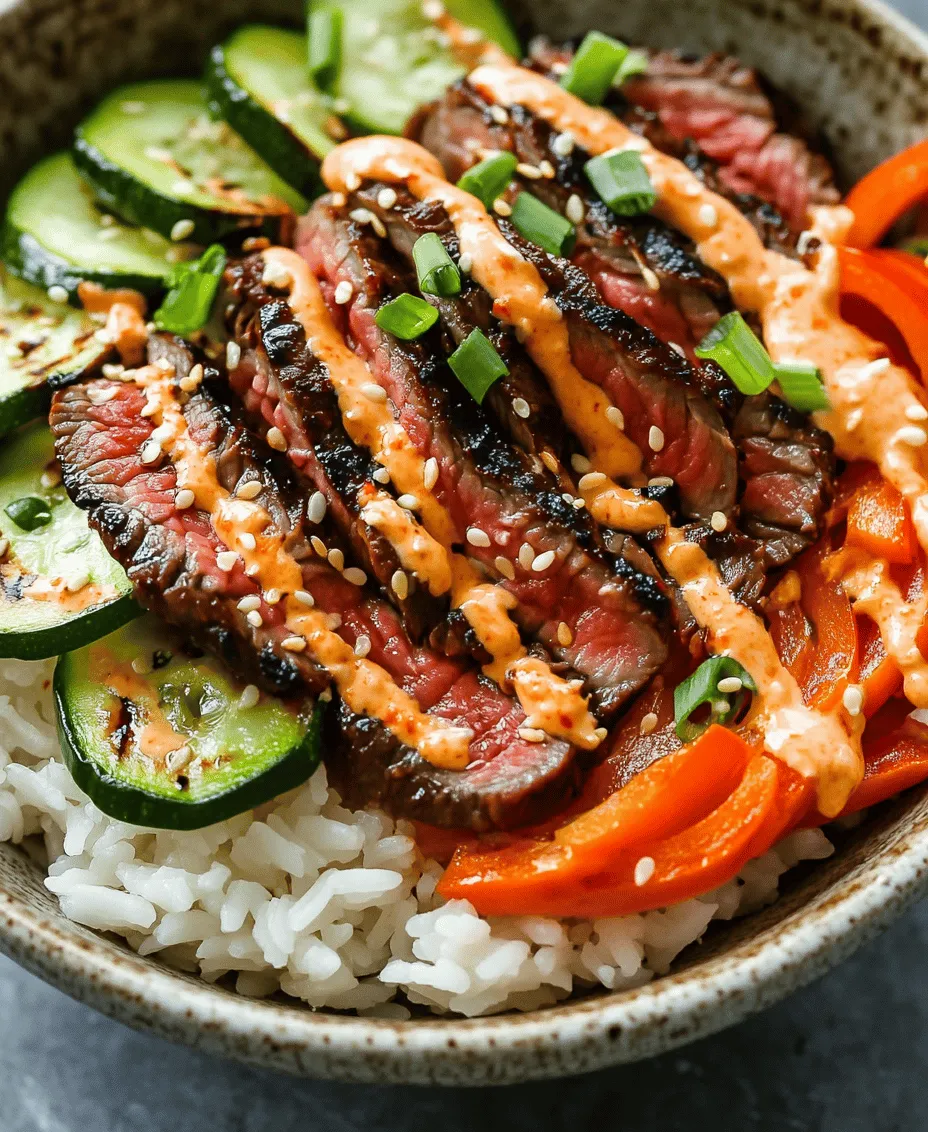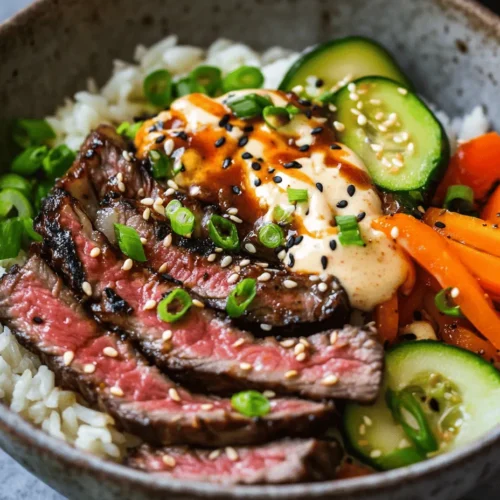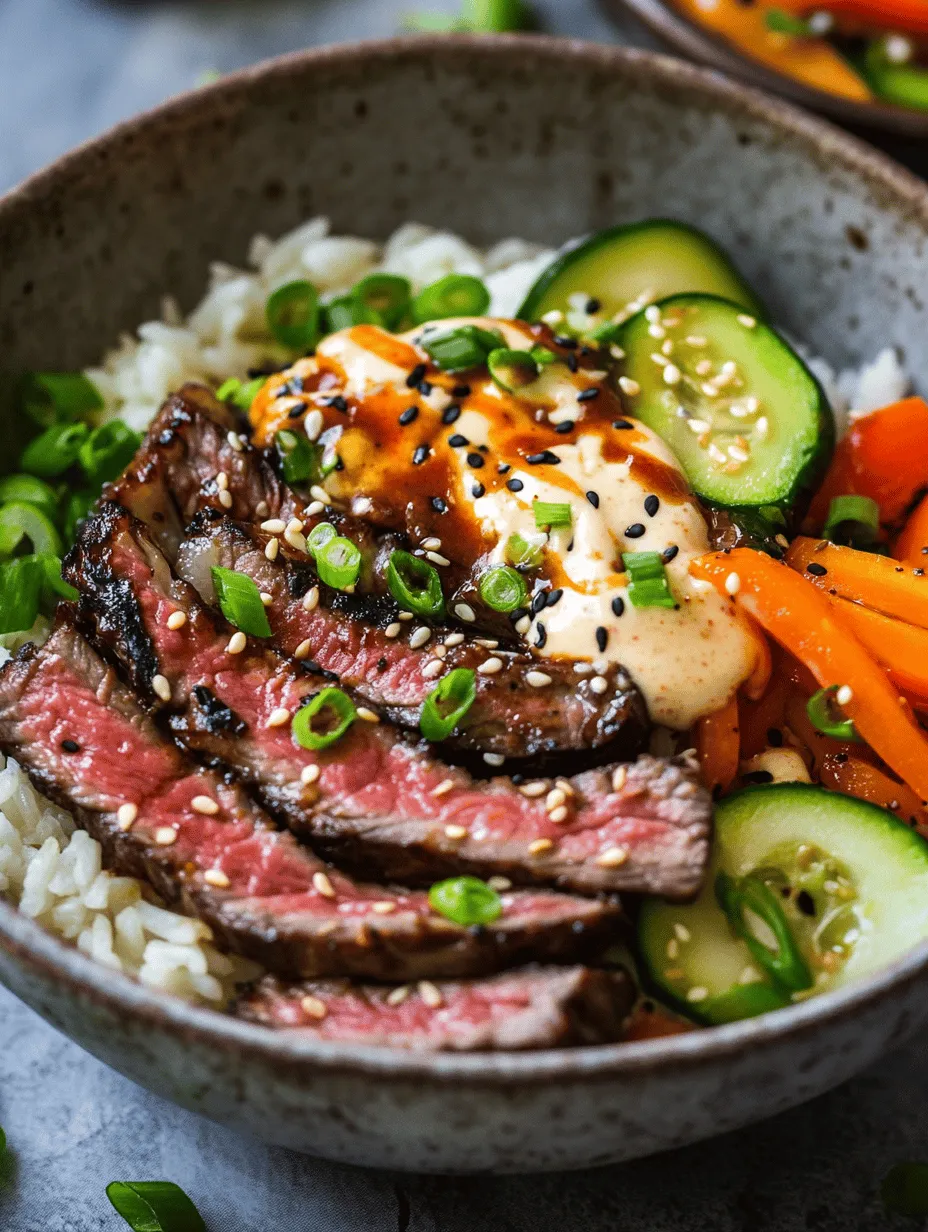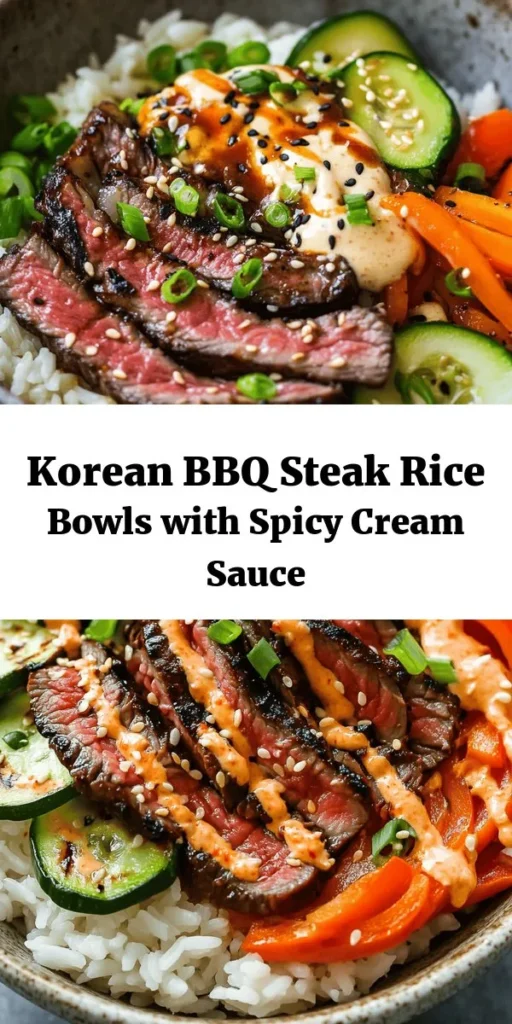Introduction
Korean barbecue, often referred to as “gogi-gui,” has become a beloved culinary trend worldwide, celebrated not only for its mouthwatering flavors but also for its cultural significance. This communal style of dining typically involves grilling marinated meats at the table, creating an interactive and lively experience. The aroma of sizzling steak, the vibrant colors of fresh vegetables, and the rich array of dipping sauces all contribute to the unique charm of Korean BBQ. Among the many dishes inspired by this culinary tradition, the Korean BBQ Steak Rice Bowls with Spicy Cream Sauce stand out as a delightful fusion of flavors, convenience, and nutrition.
This recipe encapsulates the essence of Korean BBQ while offering a modern twist—it’s perfect for busy lifestyles, serving four and designed for swift preparation. Each bite delivers a burst of savory goodness, showcasing tender flank steak marinated in a flavorful blend, accompanied by fragrant jasmine rice, crisp vegetables, and a creamy, spicy sauce that ties everything together. Not only is this dish a feast for the senses, but it also aligns well with health-conscious eating, balancing protein, carbs, and fresh produce. Whether you’re hosting a casual dinner or simply seeking a comforting meal, these Korean BBQ Steak Rice Bowls are sure to impress.
Understanding the Ingredients
To create the perfect Korean BBQ Steak Rice Bowls with Spicy Cream Sauce, it is essential to understand the significance and role of each ingredient. From the marinade that infuses the steak with flavor to the creamy sauce that elevates the dish, each component is carefully chosen for its contribution to the overall taste.
Flank Steak
Flank steak is the star of this dish and is a staple in Korean BBQ due to its rich flavor and relatively low cost. This cut of meat comes from the abdominal muscles of the cow, making it lean yet tender when cooked correctly. What makes flank steak particularly suitable for marinating is its fibrous texture, which allows it to absorb flavors beautifully, resulting in a deliciously savory bite. When prepared and sliced properly, flank steak can be incredibly tender, making it a popular choice for grilling and stir-frying in Korean cuisine.
Jasmine Rice
Jasmine rice is the perfect companion for our Korean BBQ steak, known for its fragrant aroma and slightly sticky texture. This long-grain rice, primarily grown in Thailand, has a subtle floral scent and a soft, fluffy consistency when cooked. The slight stickiness of jasmine rice helps it to hold together, making it easy to scoop up with chopsticks or a fork alongside the flavorful steak and vegetables. Jasmine rice complements the savory notes of the dish, providing a neutral base that balances the bold flavors of the marinade and the spicy cream sauce.
Gochujang
A key ingredient in many Korean dishes, gochujang is a fermented chili paste that brings depth and complexity to the flavors of this recipe. Made from red chili powder, glutinous rice, fermented soybeans, and salt, gochujang has a unique balance of spiciness, sweetness, and umami. Its thick texture allows it to cling to the meat and rice, enhancing every bite with a rich, savory taste. In addition to its flavor profile, gochujang is also recognized for its health benefits, including antioxidants and various vitamins.
Other Key Flavor Components
In addition to gochujang, several other ingredients play crucial roles in crafting the marinade and overall flavor of the dish:
– Soy Sauce: A fundamental ingredient in Korean cuisine, soy sauce adds saltiness and umami depth to the marinade. Its rich, savory flavor enhances the overall taste of the steak, making it more delectable.
– Sesame Oil: This nutty oil contributes a fragrant aroma and a subtle richness to the marinade. A little goes a long way, enhancing the flavor without overpowering it.
– Garlic and Ginger: Freshly minced garlic adds a sharp, aromatic quality, while ginger provides warmth and earthiness. Together, they create a well-rounded flavor profile that complements the beef beautifully.
– Rice Vinegar: This mild vinegar adds a tangy note to the marinade, balancing the richness of the meat and other ingredients. It helps tenderize the steak while enhancing the overall flavor.
Overview of the Vegetables
Colorful vegetables not only add a vibrant touch to the Korean BBQ Steak Rice Bowls but also contribute important nutrients. Common choices include bell peppers, carrots, and cucumbers, each bringing its unique texture and flavor. Bell peppers add sweetness and crunch, while carrots provide a slight earthiness. Cucumbers offer a refreshing crunch that contrasts with the rich flavors of the steak and sauce.
Including a variety of vegetables not only enhances the visual appeal of the dish but also boosts its nutritional profile. These veggies are packed with vitamins, minerals, and fiber, making your meal not only delicious but also healthful.
The Spicy Cream Sauce
The spicy cream sauce is a standout element of this dish, designed to provide a creamy texture that balances the bold flavors of the marinated steak and vegetables. Typically made with a base of mayonnaise or sour cream, this sauce incorporates gochujang for heat, along with a splash of rice vinegar for acidity. The result is a rich, tangy sauce that brings harmony to the dish, ensuring that each component works together seamlessly. This sauce can be adjusted to your desired spice level, making it versatile for different palates.
Preparing the Flank Steak
The preparation of flank steak is crucial for achieving the best results in our Korean BBQ Steak Rice Bowls. The marinating process not only infuses the meat with flavor but also tenderizes it, making for a more enjoyable dining experience.
Importance of Marinating
Marinating is an essential step when preparing flank steak. The marinade works to break down the muscle fibers, resulting in a more tender and flavorful piece of meat. A well-crafted marinade consists of acidic components (like rice vinegar), aromatic ingredients (like garlic and ginger), and flavor enhancers (like soy sauce and gochujang). The combination of these elements ensures that the steak absorbs maximum flavor while becoming tender.
How Marinade Ingredients Work Together
In this recipe, the marinade ingredients complement each other beautifully. The soy sauce provides a salty foundation, while the gochujang adds spice and depth. The sesame oil enriches the flavor with its nuttiness, while the garlic and ginger contribute aromatic qualities. When combined, these ingredients create a dynamic marinade that penetrates the meat, resulting in a steak that is both flavorful and succulent.
Time Considerations for Marination
For optimal results, it’s recommended to marinate the flank steak for a minimum of 30 minutes. However, for maximum flavor, aim for at least 2 hours or even overnight in the refrigerator. The longer the meat marinates, the more pronounced the flavors will be. Just be cautious not to exceed 24 hours, as the acidity in the marinade can start to break down the meat too much, resulting in an undesirable texture.
Tips for Slicing Flank Steak Against the Grain
Once the steak is marinated and cooked, slicing it correctly is essential for tenderness. Always slice flank steak against the grain. The “grain” refers to the direction the muscle fibers run in the meat. By cutting against the grain, you shorten the fibers, making each bite easier to chew and more enjoyable. Look for the lines in the steak and cut perpendicular to them for optimal results.
Cooking the Jasmine Rice
Jasmine rice is integral to our Korean BBQ Steak Rice Bowls, providing a flavorful and aromatic base that complements the steak and sauce. Here’s a step-by-step guide to ensure your jasmine rice comes out perfectly every time.
Step-by-Step Guide to Rinsing and Cooking Jasmine Rice
Rinsing: Begin by measuring out the desired amount of jasmine rice. Rinse the rice under cold running water in a fine-mesh strainer until the water runs clear. This step is crucial for achieving the right texture, as it removes excess starch that can make the rice gummy. Rinsing allows the rice to cook up fluffy and separate, enhancing the overall quality of your dish.
Cooking Methods: You can use either a rice cooker or a stovetop method to cook jasmine rice. If using a rice cooker, simply follow the manufacturer’s instructions for water-to-rice ratios and cooking times. For stovetop cooking, use the following method:
1. Combine 1 cup of rinsed jasmine rice with 1.5 cups of water in a medium saucepan.
2. Bring the mixture to a boil over medium-high heat.
3. Once boiling, reduce the heat to low, cover the pot, and let it simmer for about 15 minutes or until the water is absorbed and the rice is tender.
4. Remove from heat and let it sit, covered, for an additional 5 minutes to steam and finish cooking.
5. Fluff the rice with a fork before serving.
Suggestions for Variations in Rice Preparation
While jasmine rice is a perfect choice for this dish, you can also experiment with other types of rice or cooking methods. For a richer flavor, consider cooking the rice in broth instead of water. Chicken or vegetable broth can add extra depth and complement the savory flavors of the steak. Additionally, you can incorporate spices or aromatics, such as garlic or ginger, into the cooking water for added fragrance.
By understanding the importance of each component in the preparation of Korean BBQ Steak Rice Bowls with Spicy Cream Sauce, you can create a dish that not only satisfies the palate but also celebrates the rich traditions of Korean cuisine. The next steps involve crafting the spicy cream sauce, which will enhance the dish’s flavor profile and provide a creamy, satisfying finish.

Adjusting Spice Levels: Tips for Personalizing the Heat
One of the best parts of cooking is the ability to customize your dish to suit your taste preferences, and the spicy cream sauce for these Korean BBQ steak rice bowls is no exception. If you enjoy a little heat, feel free to amp up the spice by adding more gochujang or sriracha. For those who prefer a milder flavor, consider starting with a smaller amount and gradually increasing it to your desired heat level.
You can also balance the heat by adding a touch of sweetness with honey or brown sugar, which complements the spiciness beautifully. Additionally, incorporating dairy elements like sour cream or yogurt can tone down the heat while adding creaminess to the sauce. Remember, the goal is to create a sauce that not only enhances the steak and rice but also aligns with your personal spice tolerance.
How the Sauce Complements the Other Components of the Dish
The spicy cream sauce acts as a unifying element in the Korean BBQ steak rice bowls. With its rich, tangy, and spicy profile, it enhances the flavor of the marinated steak, complements the freshness of the vegetables, and adds a delightful creaminess that ties everything together. The contrast of textures—from the tender steak to the crunchy vegetables and creamy sauce—creates a satisfying mouthfeel in every bite.
Moreover, the sauce’s umami flavor plays well with the savory notes of the steak, while its spiciness elevates the overall flavor profile of the bowl. This harmonious blend ensures that no single component overpowers the others, making each bite a delightful experience.
Sautéing the Vegetables
Choosing the Right Vegetables
Selecting the right vegetables for your Korean BBQ steak rice bowls is crucial for both flavor and visual appeal. Traditional choices include bell peppers, carrots, and broccoli, which provide a colorful array that contrasts beautifully with the meat and rice. You can also consider adding snap peas, zucchini, or even shiitake mushrooms for a more earthy flavor profile. These vegetables not only contribute to the overall taste but also provide essential nutrients.
Flavor, Texture, and Color Impact on the Dish
The vegetables you choose should offer a combination of flavor, texture, and color. Crunchy vegetables like bell peppers and snap peas add a refreshing bite, while softer vegetables like zucchini can bring a different texture to the dish. The vibrant colors can enhance the visual appeal, making the bowl more inviting. A mix of colors will not only make your meal more attractive but also ensure a variety of vitamins and minerals, contributing to a well-balanced dish.
Cooking Techniques for Maintaining Crunch and Vibrancy
To keep your vegetables crisp and vibrant, opt for quick sautéing over high heat. This method allows them to cook through while retaining their natural crunch and bright colors. Use a splash of oil in a hot pan to quickly stir-fry the vegetables for about 3-5 minutes. You want them tender but still crisp, so keep an eye on them to avoid overcooking. A sprinkle of salt and a dash of sesame oil at the end can enhance their flavor without compromising their texture.
Suggestions for Seasonal Vegetables or Substitutions
Depending on the season, you can incorporate a variety of vegetables into your rice bowls. In spring, consider asparagus or peas; summer might call for fresh corn or cherry tomatoes; fall could inspire the addition of roasted butternut squash or Brussels sprouts; and winter is perfect for hearty greens like kale. If you’re looking for substitutions, feel free to swap out any vegetables based on what you have on hand or your personal preferences.
Cooking the Steak to Perfection
Techniques for Cooking Flank Steak
Flank steak is an excellent choice for this recipe due to its rich flavor and relatively quick cooking time. To achieve the best results, start by marinating the steak for at least 30 minutes, but ideally for several hours or overnight. This will enhance its tenderness and infuse it with flavor. When it’s time to cook, a high-heat method is essential. Whether you choose to grill, broil, or pan-sear, aim for a hot surface that can create a nice sear on the outside while keeping the inside tender.
Importance of High Heat and Quick Cooking for Tenderness
Cooking flank steak quickly over high heat is key to preventing it from becoming tough. Ideally, you want to cook it for about 3-4 minutes on each side for medium-rare, or a bit longer if you prefer it more well done. Using a meat thermometer can help you gauge the doneness: aim for 130-135°F for medium-rare and 140-145°F for medium.
How to Achieve Desired Doneness (Medium-Rare vs. Well-Done)
To achieve the perfect doneness, it’s important to keep in mind that flank steak can easily become overcooked. If you prefer it medium-rare, make sure to pull it off the heat just below your target temperature, as it will continue to cook while resting. For well-done steak, aim for a final temperature of around 160°F.
Tips for Resting the Steak Post-Cooking to Retain Juices
Once your steak is cooked to your liking, allow it to rest for at least 5-10 minutes before slicing. This step is crucial as it helps redistribute the juices throughout the meat, ensuring every bite is flavorful and moist. Tent the steak with aluminum foil during this time to keep it warm.
Assembling the Rice Bowls
Visual Appeal: Layering Components for Aesthetic and Flavor
When assembling your rice bowls, presentation is key. Start with a generous scoop of rice as the base, then layer the sautéed vegetables and sliced steak on top. Aim for a balance of colors and textures; for instance, the vibrant greens and reds of the vegetables will contrast beautifully with the golden brown steak.
Suggestions for Portion Sizes and Arranging Ingredients
For portion sizes, consider around 1 cup of cooked rice per person, topped with 1/2 cup of sautéed vegetables and 4-6 ounces of sliced steak. Arrange the components in a way that is visually appealing—consider placing the steak slices at an angle on one side of the bowl and the vegetables on the other.
Importance of Garnishing with Green Onions and Sesame Seeds for Texture and Flavor Enhancement
To finish, garnish your rice bowls with thinly sliced green onions and a sprinkle of sesame seeds. Not only do these toppings add a nice crunch, but they also enhance the overall flavor profile. The green onions bring a fresh bite, while sesame seeds lend a nutty richness that complements the dish beautifully.
Serving Suggestions
Ideas for Side Dishes or Beverages that Pair Well with the Rice Bowls
When serving Korean BBQ steak rice bowls, consider accompanying them with light side dishes such as a simple cucumber salad, pickled vegetables, or a refreshing kimchi. These sides provide a nice contrast to the rich flavors of the main dish. For beverages, a chilled Korean rice wine (makgeolli) or a light lager can pair well, balancing the meal’s richness.
Presentation Tips for Serving to Guests or Family
If you’re serving guests or family, consider using individual bowls for a more personalized touch. You can also lay out the ingredients buffet-style, allowing everyone to customize their rice bowls according to their taste. This interactive dining experience can elevate the meal and make it more enjoyable.
Nutritional Analysis
Overview of Nutritional Benefits: Protein, Fiber, Vitamins, and Minerals
Korean BBQ steak rice bowls are not only delicious but also packed with nutrition. The flank steak provides a substantial amount of protein, which is essential for muscle repair and growth. The accompanying vegetables are rich in fiber, vitamins, and minerals, contributing to a well-rounded meal.
Discussion on Balancing Meals with the Inclusion of Vegetables and Healthy Fats
Incorporating a variety of vegetables not only enhances the flavor but also ensures that your meal is balanced. The fiber from the veggies helps with digestion, while healthy fats can be introduced through garnishes like sesame oil or avocado. This balance is key to maintaining energy levels and supporting overall health.
Consideration for Dietary Preferences (e.g., Gluten-Free Options)
For those with dietary restrictions, this recipe is quite versatile. You can easily make it gluten-free by ensuring that the soy sauce is gluten-free or by using tamari. Additionally, the dish can be adapted for those following a low-carb diet by substituting rice with cauliflower rice or leafy greens.
Conclusion
Korean BBQ steak rice bowls with spicy cream sauce are a delightful and versatile dish that showcases the best of Korean cuisine. They offer a perfect blend of flavors, textures, and colors, making them a feast for both the eyes and the palate. This recipe invites creativity, allowing you to experiment with different ingredients and spice levels to suit your preferences.
Whether you’re enjoying a cozy weeknight dinner or impressing guests at a gathering, these rice bowls are sure to please. Embrace the joy of homemade Korean BBQ and all the deliciousness it brings to your kitchen!



